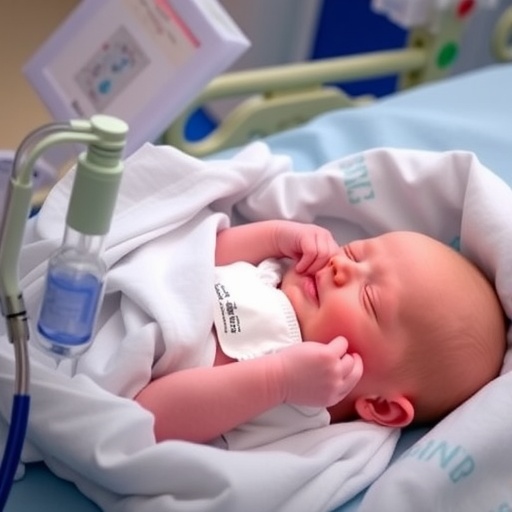In a groundbreaking systematic scoping review published in Pediatric Research, researchers have cast new light on the delicate and complex management of analgesia and sedation in premature infants requiring invasive ventilation. This comprehensive analysis delves into a subject riddled with clinical challenges and ethical dilemmas, expanding our understanding of how best to balance efficacy and safety in this uniquely vulnerable population.
Premature infants on invasive mechanical ventilation face a turbulent confluence of stressors, including pain, discomfort, and the physiological perturbations of their immature organ systems. Unlike older children and adults, these neonates have underdeveloped metabolic pathways, altered pharmacodynamics, and heightened sensitivity to sedative and analgesic agents, making standard dosing protocols inadequate and potentially dangerous. This review synthesizes the current state of evidence, highlighting significant gaps and proposing a framework that could revolutionize neonatal intensive care protocols worldwide.
The study scrutinizes how analgesia and sedation are not merely supportive therapies but critical determinants of both short-term clinical stability and long-term neurodevelopmental outcomes. Excessive sedation risks respiratory depression and prolonged ventilation, whereas insufficient pain management can exacerbate stress responses, leading to inflammation and neurotoxicity. The nexus of these opposing dangers underscores the timeliness of this systematic review, unrivaled in scope and rigor.
Analyzing an extensive corpus of clinical trials, cohort studies, and pharmacological investigations, the authors uncover marked heterogeneity in sedation practices across neonatal intensive care units globally. Such variability reflects differing institutional policies and physician preferences but also underscores the absence of universally accepted guidelines. This inconsistency has direct implications for patient safety and efficacy of pain relief in premature infants.
The pharmacological arsenal used in this demographic—including opioids like morphine and fentanyl, benzodiazepines such as midazolam, and adjunctive agents like dexmedetomidine—has been assessed for both benefits and pitfalls. Of particular concern are neurodevelopmental consequences linked to prolonged opioid exposure, which the review explores with an eye to recent findings in animal models and human cohorts. These findings demand a reevaluation of risk-benefit paradigms that have heretofore guided clinical practice.
Beyond drugs alone, the review integrates insights on multimodal approaches incorporating non-pharmacologic strategies. Techniques such as facilitated tucking, non-nutritive sucking, and tailored caregiving are discussed as vital adjuncts that may reduce reliance on pharmacotherapy. By contextualizing sedation and analgesia within a holistic care model, the authors advocate for patient-centered protocols that respect both biochemical and psychosocial dimensions of neonatal pain.
A salient feature of this research is the critical appraisal of sedation assessment tools designed explicitly for preterm infants. The review highlights the limitations of existing scales, which often fail to capture subtle behavioral and physiological indicators of distress in this population. This gap contributes to under- or overtreatment, impeding optimal management, and calls for development of novel, validated pain assessment methodologies suited for neonates receiving invasive ventilation.
Importantly, the review elucidates the pharmacokinetic and pharmacodynamic intricacies that make drug dosing in premature infants exceptionally challenging. Immature hepatic and renal function, altered blood-brain barrier permeability, and receptor sensitivity variations demand individualized dosing regimens underpinned by robust therapeutic drug monitoring. The authors emphasize that only through precision medicine approaches can clinicians attain effective analgesia while minimizing adverse outcomes.
Another pivotal consideration dissected in the paper is the ethical dimension of sedation and analgesia in this fragile group. Decisions surrounding the initiation, intensity, and duration of sedation involve weighing immediate comfort against potential long-term harms. The review situates these decisions within the bioethical framework of beneficence, non-maleficence, and respect for future autonomy, urging neonatologists to integrate family values and multidisciplinary consultations in care plans.
The review also ventures into emerging pharmacologic agents showing promise for safer sedation practices in neonates on ventilation. Drugs such as dexmedetomidine, a selective alpha-2 adrenergic agonist, have demonstrated analgesic and sedative properties with favorable safety profiles compared to benzodiazepines and opioids. Early clinical data are encouraging, yet the authors stress the need for large-scale trials to establish efficacy and safety definitively.
Clinical outcomes associated with various sedation and analgesia strategies form another core focus. Metrics such as duration of mechanical ventilation, incidence of intraventricular hemorrhage, neurodevelopmental milestones, and survival rates are analyzed. The review’s integrative approach reveals that nuanced sedation protocols can positively influence these outcomes, catalyzing improvements in both short- and long-term neonatal health.
Critically, the authors expose glaring shortcomings in current research, including small sample sizes, lack of randomized controlled trials, and inconsistency in outcome reporting. These limitations hamper the formulation of evidence-based guidelines and underscore the urgency for international collaborative efforts to conduct robust, high-quality studies on analgesia and sedation in premature infants.
The article thereby concludes with a clarion call for the development of standardized practice guidelines integrating pharmacologic and non-pharmacologic therapies, sophisticated pain assessment tools, and precision dosing protocols. The systematic scoping review stands as a pivotal foundation upon which future research, clinical practice, and policy can build to better serve the most vulnerable patients—premature infants requiring invasive ventilation.
Moving forward, the seamless integration of novel biomarkers, advanced monitoring technologies, and artificial intelligence-driven personalized models is envisioned to transform analgesia and sedation management. Such interdisciplinary innovation holds the key to reducing morbidity and enhancing quality of life for premature neonates worldwide.
As this review gains traction within the neonatology community, its insights are anticipated to spur a paradigm shift, inciting critical reappraisal of sedation protocols and fostering research that places neonatal safety and neurodevelopment at the forefront of clinical priorities. This transformative potential positions the article as a seminal contribution destined to influence clinical guidelines and neonatal care standards for years to come.
Subject of Research: Analgesia and sedation management in premature infants undergoing invasive mechanical ventilation
Article Title: Analgesia and sedation in premature infants receiving invasive ventilation: a systematic scoping review
Article References:
Moultrie, F., Durrmeyer, X., van den Bosch, G.E. et al. Analgesia and sedation in premature infants receiving invasive ventilation: a systematic scoping review. Pediatr Res (2025). https://doi.org/10.1038/s41390-025-04441-y
Image Credits: AI Generated
DOI: 20 November 2025




